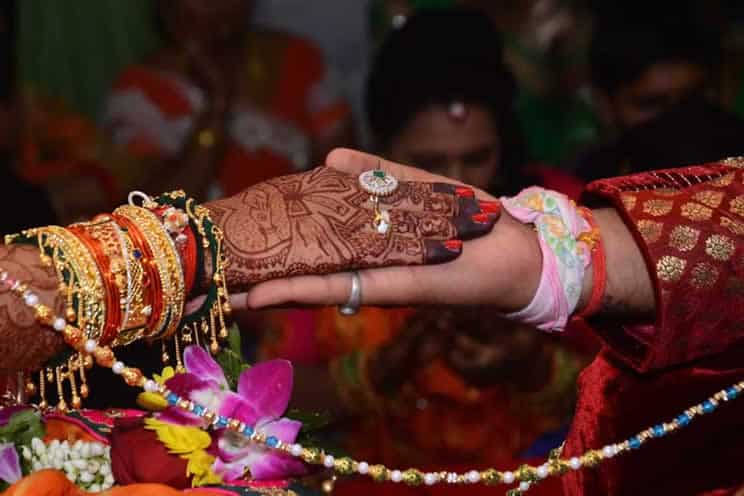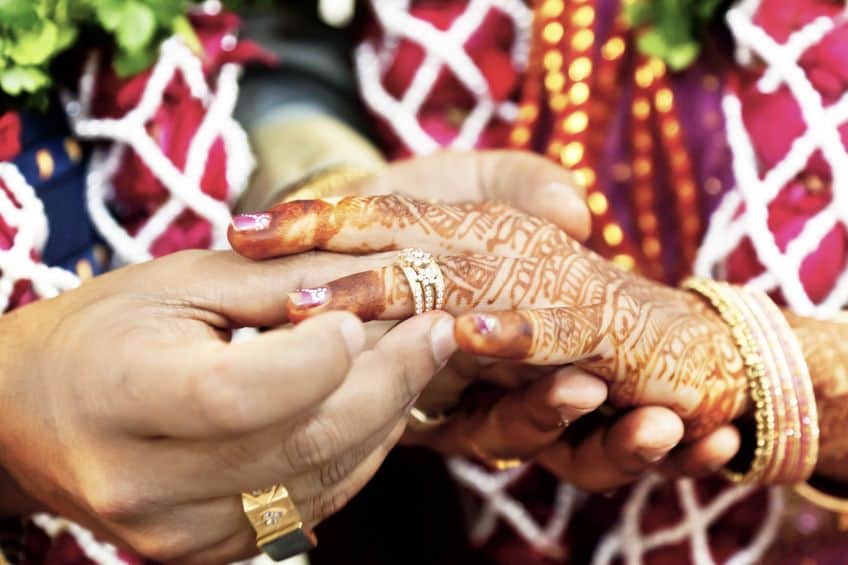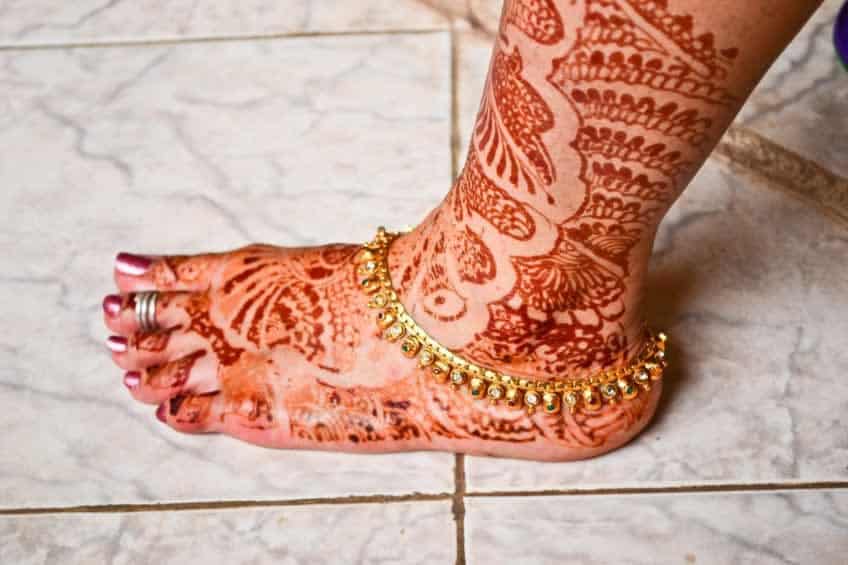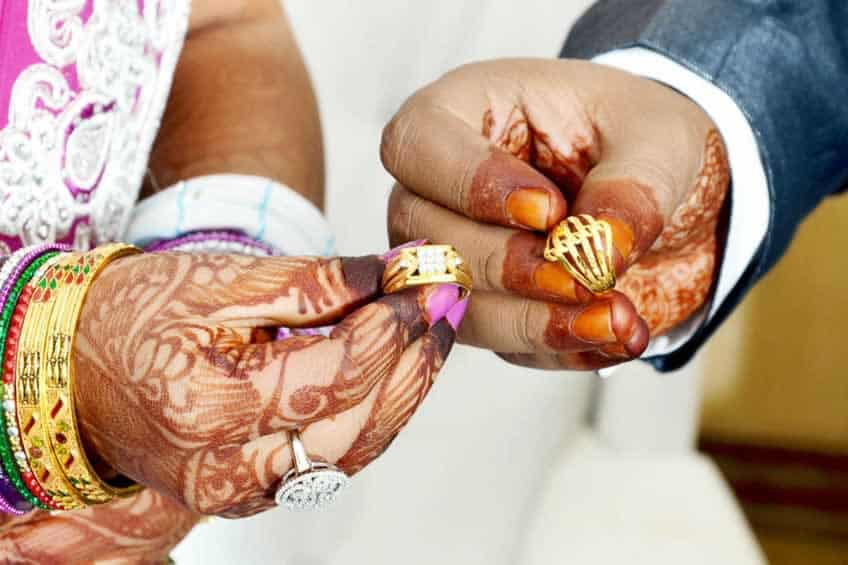
I wanted to find out if Hindus wear wedding rings and whether wedding rings being exchanged were part of the wedding ceremony. Or was it just more of a western tradition, adopted by Hindus who had emigrated out of India.
Do Hindus wear wedding rings? Hindus do wear wedding rings to symbolize being married, with wedding rings being placed generally on the left hand, in line with western traditions. Traditionally the right hand was commonly used as the left hand was considered evil and unclean. Special wedding rings can also be worn on the toes.
Rings can be worn in different pre-wedding and wedding ceremonies to mark the marriage including:
- Wedding Rings
- Engagement (Sagai) Rings
- Pre-Engagement (Roka) Rings
Unlike western traditions, the wedding rings can also be placed on the right hand instead of the left one. With the equivalent of the ring finger (third finger from the thumb) being used on the right hand or even different fingers being used.
The historical reasoning behind wearing rings on the right hand instead of the left was down to the belief the left hand symbolized evil or was unclean and therefore would bring bad luck to the wedding ring wearer.
Other countries like Russia, Germany and Norway also wear wedding rings on the right hand and again this has been down to similar historic beliefs as the Hindus about wearing a ring on the left hand.
Rings are also exchanged during the different ceremonies that make up the Hindu wedding including the Roka, Sagai and the Mangalya Dharanam (wedding ceremony), with finger rings as well as toe rings exchanged in some scenarios. It’s essential to plan any Hindu wedding to make sure all the ceremonies including those involving rings all go to plan, see my Hindu Wedding planning guide for more details.
These ceremonies are discussed below:
1. Wedding Rings
Wedding rings (or the engagement rings are re-exchanged) are exchanged during the wedding ceremony, not as a formal sign to declare the couple as being married, as it can be in other religions. Instead, the wedding ring exchange has been adopted and usually follows the other practices where marriage confirmation takes place.
Traditionally some Hindu wedding ceremonies used toe rings (see below) as part of the ceremony instead of finger rings. With both the bride and bridegroom in some instances putting toe rings onto each other.
Mangalya Dharanam (Mangalsutrabandhanam)
It’s towards the end of the wedding during the Mangalya Dharanam ceremony (where the marriage commitment between bridegroom and bride is established) that the wedding rings are exchanged.

Other formalities from traditions are adhered to, including putting the Mangalsutra (sacred thread in Sanskrit), a necklace around the bride’s neck by the bridegroom. To symbolize marriage, the groom ties knots into the necklace (Mangalsutra) around the bride’s neck, this is known as the ‘tying of the knots’ part of the Hindu wedding ceremony. (Check out the latest mangalsutra designs here)
The ‘tying of the knots’ ceremony varies across different Hindu groups but generally, three knots are tied. With the bridegroom tying two knots and his sister (or mother) tying the third knot.
The first two knots tied by bridegroom represent the commitment of the couple, where the bridegroom commits to taking care of the bride and the bride commits to taking care of the bridegroom.
The third knot is tied by the sister (or mother) and symbolizes the commitment between the bridegroom and bride’s respective families. The marriage knots represent the permanent bond of the couple as husband and wife.
Along with the kumkum (Sindoor, a vermilion red or orange-red coloured powder) being applied by the groom to the bride’s forehead and reciprocation by the bride of applying Chandan tilak (sandalwood paste), symbolizes the bride becoming the groom’s wife.
Once the Mangalsutra has been tied and the Kumkum applied by the groom, the wedding rings are normally exchanged. The exchange of rings has grown to become a commitment between the newly married couple of unconditional love and support for each, whatever challenges they may face going forward.
Find out about the 13 Ways Hindu weddings are celebrated.
Toe Rings
Toe rings (Bichiya) can also be placed on the brides second toe of each foot by the groom in some Hindu ceremonies to signify the marriage bond as well as providing a blessing for future children, as it’s believed the toe ring presses on nerves that aid in reproduction and to signify the groom’s commitment to look after the bride.

The toe rings along with the placing of the necklace (Mangalsutra) around the bride’s neck by the bridegroom, kumkum and Chandan tilak act as confirmation of the marriage is completed.
In changing times, many Hindu ceremonies have replaced the placement of toe rings with just the exchanging wedding rings towards the end of the marriage ceremony but throughout history, toe rings were an important part of the ceremony. With the toe ring signifying the husband to be’s commitment to his new wife, to look after her, with toe ring providing luck.
Wearing wedding rings
In today’s modern times, both the husband and wife will wear the wedding rings to symbolize their marriage, with the new wife also carrying on wearing the necklace to show the world she is married.
Those wives whose Hindu wedding tradition involved toe rings may also elect to carry on wearing these toe rings as well as wearing their wedding ring to symbolize being married.
The placement of wedding rings varies with the right hand being used as well as the left hand along with different fingers based on the belief of differing health values.
With the belief, the ring placed on the middle finger providing healthy heart benefits and the ring on the traditional ring finger (third finger from the thumb) providing healthy brain benefits. Wedding rings with different types of gemstones are believed also to provide different health benefits.
In India, the husband may not necessarily wear the wedding ring, whilst Indian husbands who live in countries where wedding rings are worn by men, will probably in all likelihood follow suit.
Find out the difference between Jain weddings and Hindu weddings.
Types of wedding rings
Wedding rings incorporating Diamonds are believed to represent eternal love, as Diamonds are supposed to last forever, with Sapphires representing faithfulness, truth and purity.
Emeralds also symbolize faithfulness and also love, as traditionally emerald was given to the ancient Roman goddess of love, Venus, as an offering. Rubies represent commitment and love, with some also interpreting Rubies for passion.
Wedding rings incorporating gemstones from Amethyst, Pearls, Moonstone, Citrine to Garnet are believed to have many health benefits and protections like the Garnet gemstone believed to provide protection from evil. With courage and strength from the Amethyst gemstone, to positivity and happiness from Pearls and Citrine.
Historical use of wedding rings
Historically rings for wedding ceremonies including the engagement have not been customary and have never been part of Indian culture. The actual symbol of being married in the Hindu culture has always been the Mangalsutra, toe ring and bangles exchanged at the wedding ceremony for the bride.
Hindu weddings in India may not necessarily incorporate the exchanging of rings, as much as the Hindu weddings taking place in countries like the USA, UK, Canada to Australia.
Where traditional wedding ceremonies involving rings are more probable than those without. Hindu men are more likely to wear wedding rings in these countries than in India where they have not been associated with marriage as much.
2. Engagement (Sagai) Rings
The engagement ceremony (known as the Sagai) is the next stage after the Roka and can take place days, weeks or even months later. To mark the completion of the Sagai ceremony, engagement rings are exchanged between the bridegroom and the bride, with the guests receiving traditional Indian sweets (ludhoos, barfi) and dried fruits to celebrate the engagement.

The Sagai (also known as Mangani) ceremony officially celebrates the acceptance of the bridegroom’s family asking for the bride’s hand in marriage and is traditionally held at the bridegroom’s family home. With members of both the bridegroom and bride’s family present at the ceremony, along with friends.
In recent times, the Sagai has expanded beyond the bridegroom’s place of residence to banqueting hall and purpose-built venues being hired to accommodate a large number of guests and family members. These lavish settings include catered food for dinner (or lunch, depending on the ceremony timing) and decoration to elicit the importance of the Sagai ceremony.
With many guests being accommodated for what in essence has been traditionally a small family affair, with only the men from the bride’s family being invited to the bridegroom home.
What’s the engagement ring finger for males and females in Hindu tradition?
Traditionally the engagement ring is worn on the right hand by both Hindu males and females, as the left hand has always been looked at as unfavourable. Hindu females outside of India, especially in Western societies tend to follow more western ideals on engagement ring placement, settling for the left hand and the third finger, whilst men still opt for the right hand.
3. Pre-Engagement (Roka) Rings
The Roka ceremony has traditionally not involved any exchanges of rings between the prospective bride and bridegroom, however in today’s Roka ceremonies, rings may be exchanged to symbolize the official union of the couple to be engaged and that agreement from their families to progress to the union of marriage has been made. It’s a declaration of intent for the couple to get married by their parents.
The Roka (also known as Rokna) ceremony marks an official endpoint where parents end their search for potential suitors for their sons or daughters, as a suitable suitor has been found. The Roka is confirmation that no further marriage proposals will be entertained by the son or daughter’s parents, as the son or daughter are now going to be married to an agreed suitor.
The Roka ceremony is the first part of the wedding ceremony, confirming that the preparations are now underway for the engagement and the actual wedding.
Related Questions:
Why do Hindu brides wear red? The colour red is probably the most popular colour used and is symbolic of many different means including ‘new life’, fertility, passion, fire (as purifier) and is also the colour worn by many depictions of Hindu Goddesses.
What is the Hindu wedding ceremony length? Hindu wedding ceremonies are long and can last several days, with three days being typical in many countries like India. In the Western world, the ceremony may take place just over a weekend.

